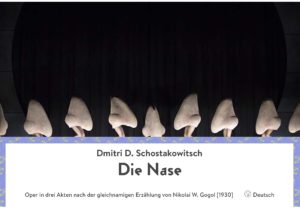THE STORY:
The Nose, Op. 15, (Russian: Нос, translit. Nos[a 1]), is Dmitri Shostakovich’s first opera, a satirical work completed in 1928 based on Nikolai Gogol’s story of the same name (1836).
The opera was written between 1927 and 1928. The libretto is by Shostakovich, Yevgeny Zamyatin, Georgy Ionin, and Alexander Preis. Shostakovich stated it was a satire on the times of Alexander I.[1] The plot concerns a Saint Petersburg official whose nose leaves his face and develops a life of its own.
Gogol’s original work was expanded by borrowing from some of his other works, including “The Overcoat”, Marriage, “Diary of a Madman”, and Dead Souls as well as The Brothers Karamazov (1881) by Dostoyevsky. The latter occurs in act 2, scene 6, where Kovalev returns home to find Ivan singing. The song is Shostakovich’s setting of the words of part 2, book 5, chapter 2 of Karamazov, where the lackey, Smerdiakov, sings to his neighbour Mariia Kondratevna.
An invisible force ties to my beloved. Bless us, O Lord, her and me! Her and me! I’ll give up a king’s crown, if my beloved is happy. Bless us, O Lord, her and me! Her and me![This quote needs a citation]
Shostakovich uses a montage of different styles, including folk music, popular song and atonality. The apparent chaos is given structure by formal musical devices such as canons and quartets, a device taken from Alban Berg’s Wozzeck.
According to the British composer Gerard McBurney writing for Boosey & Hawkes, “The Nose is one of the young Shostakovich’s greatest masterpieces, an electrifying tour de force of vocal acrobatics, wild instrumental colours and theatrical absurdity, all shot through with a blistering mixture of laughter and rage… The result, in Shostakovich’s ruthlessly irreverent hands, is like an operatic version of Charlie Chaplin or Monty Python… despite its magnificently absurd subject and virtuosic music, The Nose is a perfectly practical work and provides a hugely entertaining evening in the theatre.”[2]
